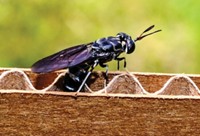Advertisement
Grab your lab coat. Let's get started
Welcome!
Welcome!
Create an account below to get 6 C&EN articles per month, receive newsletters and more - all free.
It seems this is your first time logging in online. Please enter the following information to continue.
As an ACS member you automatically get access to this site. All we need is few more details to create your reading experience.
Not you? Sign in with a different account.
Not you? Sign in with a different account.
ERROR 1
ERROR 1
ERROR 2
ERROR 2
ERROR 2
ERROR 2
ERROR 2
Password and Confirm password must match.
If you have an ACS member number, please enter it here so we can link this account to your membership. (optional)
ERROR 2
ACS values your privacy. By submitting your information, you are gaining access to C&EN and subscribing to our weekly newsletter. We use the information you provide to make your reading experience better, and we will never sell your data to third party members.
Business
Entrepreneur Promotes Process For Getting Chitin From Shrimp
Mumbai-based entrepreneur promotes new chitin extraction technique
by Jean-François Tremblay
July 30, 2012
| A version of this story appeared in
Volume 90, Issue 31

A German entrepreneur is seeking large shrimp harvesters worldwide that will install an innovative chitin production process. They need not have any knowledge of the chitin market; his company will buy all the material that they can make with his technology.
Meet Christopher Bluemel, founder of Mumbai-based i-Chess. He set up the company five years ago after an 18-year career in sales and manufacturing for Bayer and Lanxess in Germany, China, and India. i-Chess develops and makes chemical intermediates at a plant south of Mumbai; designs, produces, and exports nitrogen generators; and performs toxicity testing for companies that need to comply with Europe’s chemical safety law.
Extracting chitin from shrimp shells is Bluemel’s newest idea. For this project, he teamed up with Vijay Kirpalani, chief executive officer of Pi-Process Intensification Experts, a chemical engineering consulting firm that strives to design highly efficient production processes.
While working together on an unrelated project, they came up with a business plan for chitin centered on a process designed by Kirpalani.
“I know the global chitin market, but I don’t know necessarily how to do business in Morocco, Vietnam, Thailand, Indonesia, Ecuador, and the other countries that are major shrimp producers,” Bluemel says.
Their business plan is to sell chitin plants to shrimp farmers around the world, teach them how to produce chitin, and buy all the chitin and by-products the farmers can make. Bluemel is confident he can resell all of it. The technology, which is based on a continuous process rather than the commonly used batch process, is already installed at two shrimp processors in India. Kirpalani claims that his units are extremely simple to operate.
In recent months, Bluemel has been visiting potential customers in Thailand and China. i-Chess is making the process available to established chitin makers, but he is primarily targeting shrimp companies, which he sees as the more likely buyers. “If they’ve been producing chitin for a long time, they won’t be receptive to a newcomer to the business who claims to have a better way,” he says.
Extracted by using acids and bases on the shells of crustaceans, usually shrimp, chitin has a variety of uses. About 80% of the 15,000–20,000 metric tons of chitin produced annually goes into the manufacturing of glucosamine sulfate, estimates Bjarte Langhelle, commercial director of Seagarden ASA, a marine biotechnology company that produces chitin and derivatives. i-Chess’ Bluemel estimates that global demand for chitin is far higher, reaching 60,000 metric tons annually, and worth $250 million.
Another important use for chitin is chitosan, which is used in weight-loss supplements, pharmaceutical excipients, hemostatic bandages, and in the paper and textile industries. Earlier this month, Seagarden agreed to buy BASF’s chitosan business. The deal includes a plant in Norway and Chitopharm, a pharmaceutical grade of chitosan made by a proprietary process.
“Until BASF developed pharmaceutical grades of chitosan, that market remained largely undeveloped,” Langhelle says. i-Chess’ Bluemel concurs that, indeed, it’s chitosan that will drive future growth in the chitin market.
One of the major challenges of making chitin is doing it cleanly. Most chitin producers generate a protein-rich effluent that can damage water ecology with its high chemical and biological oxygen demand, Kirpalani says. The production process he designed recovers almost all of this protein from the waste for commercial sale.
Waste treatment isn’t a problem for Seagarden, Langhelle says. The company produces its chitin and chitosan with a proprietary continuous process that, like the i-Chess technology, generates little waste.
One potential customer for the new Indian process is Golden-Shell Biochemical, a chitin producer based in China’s Zhejiang province. “It’s never been a problem to take care of our waste, it’s just that it costs us a lot to treat it,” says Rong Ye Lin, president of Golden-Shell. Lin, who met Bluemel at a trade show in Shanghai last month, sees a lot of potential in the technology.
“I’ll sign a confidentiality agreement, and then I need to go have a look at how it works, learn what investment amount is required, and perhaps we’ll order one of Bluemel’s systems,” Lin says.
Bluemel expects that within the coming year several plants making use of the technology will initiate production, most likely in Morocco, Thailand, and the U.S.
Incidentally, chitin is not currently made in the U.S., Bluemel notes. Instead, U.S. shrimp harvesters have been either disposing of the waste shells or compressing and exporting them to countries that extract chitin. It’s one consequence of globalization that U.S. firms may start sourcing technology from India to add value to fishing operations.





Join the conversation
Contact the reporter
Submit a Letter to the Editor for publication
Engage with us on Twitter